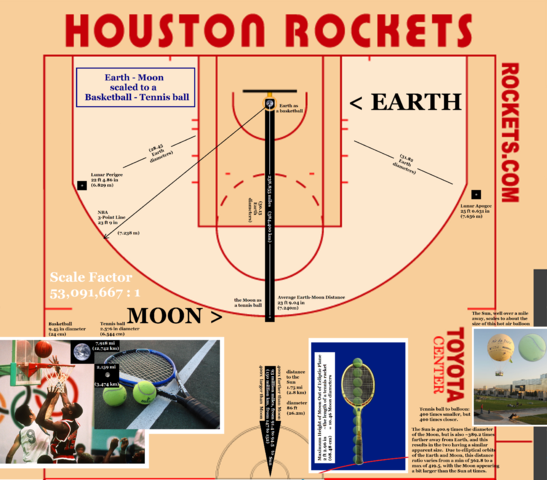 |
This is a file from the Wikimedia Commons. Information from its description page there is shown below.
Commons is a freely licensed media file repository. You can help.
|
Summary
| Description |
English: If the Earth is scaled down to the size of a basketball, then the Moon is exactly the size of a tennis ball. And the average distance from the Earth to the Moon is exactly the same as the NBA 3-point line to the hoop (its centerpoint on the floor).The Moon's perigee is 1 1/3 feet inside the 3-point line, and its apogee is 1 1/4 feet outside the line. If the court is taken to be the ecliptic plane, then the maximum height the Moon reaches while orbiting in its plane around the Earth is about the length of a tennis racket - which is also 10.46 tennis ball (Moon) diameters. At this scale, the Sun is 1 3/4 miles (2.8 km) away and its size is roughly that of a very large hot air balloon (if the Sun were centered under the hoop, its 43 foot radius would extend to just past half court, at 1.8 times the Earth-Moon distance).
The tennis ball is juxtaposed to the balloon in the photo inset on the bottom right, with the explanation as to how although the Moon is 400 times smaller than the Sun, it is 400 times closer so that when viewed from the Earth both have roughly the same apparent size. While the size ratio between the Sun and Moon is constant, their distance ratio varies because of the elliptical orbits of the Earth and Moon. When the Earth is farthest from the Sun and the Moon is closest to the Earth, the Sun-Moon distance ratio is 419.5 and the Moon appears largest with respect to the Sun. When the Earth is closest to the Sun and the Moon is farthest from the Earth, this ratio is 362.8 and the Sun appears largest with respect to the Moon. And this is how annular eclipses can occur, as happened on May 20, 2012. Total eclipses can only happen when the Moon's apparent size is larger than the Sun, meaning that the distance ratio matches or exceeds the size ratio. This 400x factor can easily be checked because the Earth-Sun distance is nearly 100 million miles, whereas the Earth-Moon distance is nearly 1/4 of a million miles, which divides out to ~400.
The numbers shown in black are the scaled-down distances and sizes. The numbers in white are the actual distances and sizes of the Earth-Moon-Sun system. If this image were extended to show the full court, then the Sun-Earth L1 Lagrange point could be shown at just a few feet below the baseline opposite from the Earth.
One of the limitations in using the 3-point line for showing the Moon's apogee and perigee is that the circular arc portion is less than 180-degrees. The ideal would be to indicate these two point as opposites along the Moon's orbit. See the Talk page for more info regarding elements that were selected for this image. A total of six Wikicommons images were combined to create this image, which was made using MS-Paint and GIMP image editing software.
|
| Date |
6 January 2013, 03:02:38 |
| Source |
|
| Author |
Tdadamemd |
Licensing
|
I, the copyright holder of this work, hereby publish it under the following license:
|
File usage
The following pages on Schools Wikipedia link to this image (list may be incomplete):
This file contains additional information, probably added from the digital camera or scanner used to create or digitize it. If the file has been modified from its original state, some details may not fully reflect the modified file.
You can learn about nearly 6,000 different topics on Schools Wikipedia. SOS Childrens Villages believes education is an important part of a child's life. That's why we ensure they receive nursery care as well as high-quality primary and secondary education. When they leave school, we support the children in our care as they progress to vocational training or higher education. Have you heard about child sponsorship? Visit our web site to find out.


